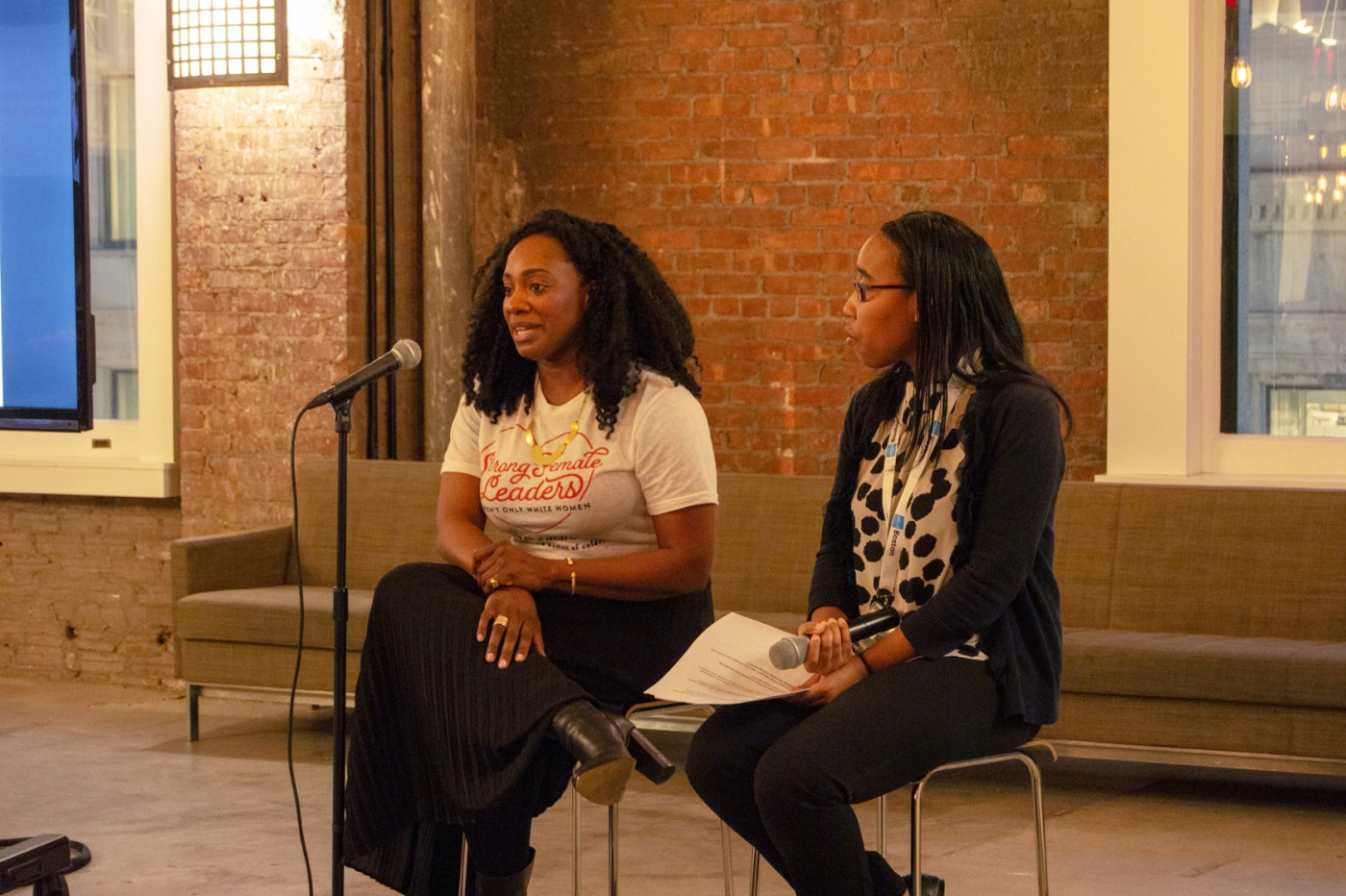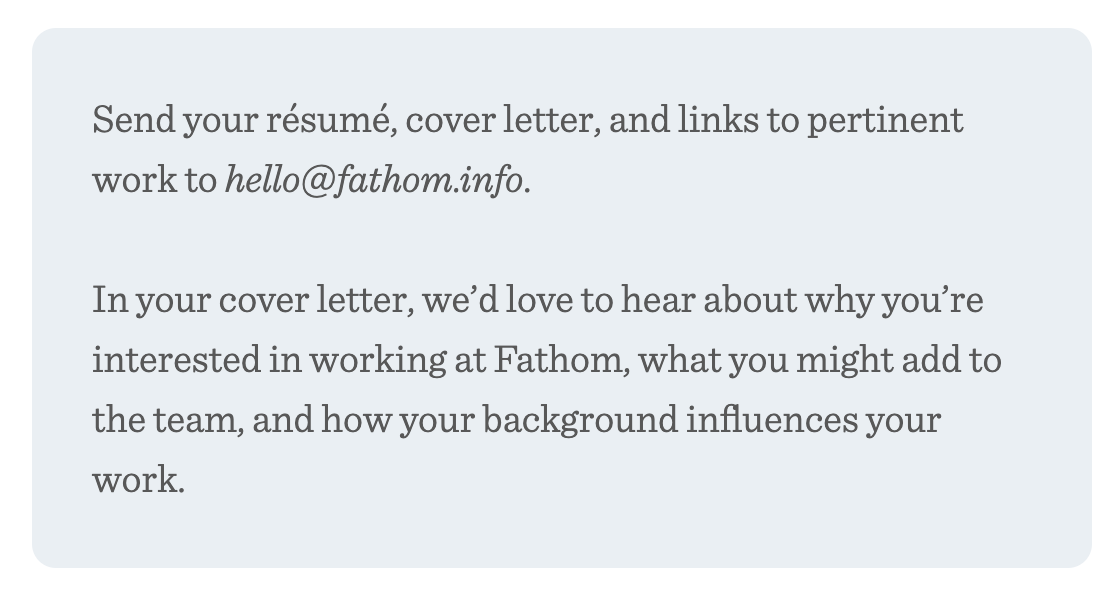

Diverse backgrounds bring perspectives that are more representative of our society. People who approach problems differently help surface a wider variety of interesting ideas. In a creative field, this is crucial to our design process. We also acknowledge that diversity goes beyond demographics, and also includes hidden experiences that shape identities.
When it comes to hiring, we want to make sure we have an inclusive process that supports our values of diversity. We also want to ensure that we don’t discriminate against applicants based on unconscious biases that tend to lead to homogenous teams. But as a company working in the intersection of design and technology, Fathom is influenced by the social context around these fields.

Design and technology both have a history of lacking diversity
Graphic design has a history of excluding people of color and women due to many factors, such as financial and educational barriers to enter the field and a lack of access to resources and role models. Minority parents are less likely to see art as a viable career path for their children, so aspiring designers may be discouraged from joining the field. Black designers also face discrimination from cultural biases against design elements more commonly used by underrepresented groups, such as more vibrant colors or a less structured approach to the design process.
The tech field has also struggled with diversity and inclusion, where the women and people of color experience racial and gender bias, are paid less for equal work, don’t get promoted as often, and face a less inclusive work environment. As a result, they are more likely to leave the industry.
Even with the values Fathom holds, this history means we need to actively and consciously take steps to make our hiring process as inclusive as possible. It’s not enough to blame the “pipeline problem” when there are also many other facets to address. We’ve done well in some aspects of building a diverse team — we have a great gender balance — but there is always room for improvement. With this in mind, we’ve revisited our hiring process over the last few months.
Designing an Inclusive Hiring Process
Last month I attended an event by AIGA on Demystifying Diverse Hiring. The speaker, Julianna Akuamoah, SVP of Human Resources at Arnold Worldwide, had many actionable suggestions for helping to create a more inclusive hiring process.

I really appreciated her discussion around avoiding the concept of “cultural fit” as a hiring criteria, which tends to encourage teams to hire more people like them. Rather, she proposed the idea of “cultural depth,” where increasing the overall cultural depth of a team promotes diversity and leads to more balanced teams.
Another well-known problem in the hiring process is implicit bias, which skews the evaluation of a candidate based on the interviewer’s biases and often leads to more homogenous teams. It can be harder to remove subjectivity when hiring in a creative field, but we spent time as a team identifying places in our process that could be improved.
Cover Letters
As a small team, we all review applications. The first thing we read is the cover letter, which we value as a way to contextualize the rest of the application. We realized that we were all independently evaluating the cover letters based on a few specific criteria, but applicants may not be aware of those, especially if they didn’t have access to career support groups or resources.

To be more transparent about our criteria, we added guidelines about cover letters to our careers page. In the process of creating these guidelines, we also had useful and thoughtful discussions with the entire team about what the criteria should be, which helped ensure that we were all on the same page and evaluating candidates fairly.
Interviews
Technical interviews are problematic for multiple reasons, including that they select for people skilled at interviewing rather than realistic work. The flaws with technical interviews most negatively impact underrepresented groups, as women are more negatively affected by imposter syndrome after a poor interview, and a high rate of false negatives (turning down qualified applicants) systematically hurts underrepresented people.
Therefore, rather than a traditional technical interview, we ask candidates to share projects from their portfolio. By asking questions about projects candidates have already done, we can get a better sense of their skills and how they would transfer to the work they would do at Fathom.
At the AIGA event, Akuamoah recommended standardizing the interview process to reduce the potential for bias. Following her suggestion, we worked to formalize the interview questions we had already been asking. We compiled a list based on hiring criteria that was representative of the questions everyone in the office thought were important. These questions are guidelines for the interviews, but we still maintain the flexibility to ask other ones where relevant. As a result, candidates have a more consistent interview experience regardless of who they interview with.
Another avenue for implicit bias is in how answers from candidates are evaluated. We wanted to avoid subconsciously changing hiring criteria to fit preconceived biases about candidates. To address this, for each question we clearly defined why we were asking the question and how we would evaluate the candidate’s answers. So far, these questions have lead to more productive discussions in our hiring process.
Making our hiring process more equitable and inclusive will be an ongoing effort, and I certainly have more to learn about this topic. These recent changes have felt like a good start to us, and we will continue to evaluate them in the coming months.
We’d love to hear what you’re working on, what you’re curious about, and what messy data problems we can help you solve. Drop us a line at hello@fathom.info, or you can subscribe to our newsletter for updates.